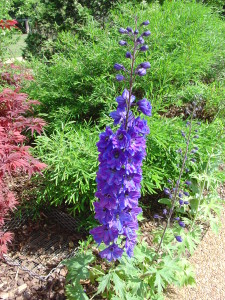Modern day delphiniums (Delphinium spp.), also called larkspurs, are the result of 2 centuries of complex breeding efforts in Europe and U.S. Delphiniums are short-lived perennials, at their best for 2-3 years. They’re most attuned to the cool temperate climes of the northern U.S. Delphiniums belong in the Buttercup (Ranunculaceae) family (USDA hardiness zones 4–7).
Most tall flowering hybrids are derived from D. elatum. Pacific Giant hybrids typically grow 4-5 feet tall on long stems. New Millennium™ hybrids from New Zealand, reportedly are better performers in warm humid zones. Taller varieties are best staked or caged to support their weak hollow stems. Flower colors range from blue, pink, lilac, and white.
Plant delphinums in full sun and in mildly acidic, well-drained, compost-rich soil. Light midday shade is recommended in southerly zones. Soil pH between 6.0 and 7.0 is ideal. Soil drainage is key! Do not allow soil to become overly dry nor stay forever soggy. Delphiniums respond to a steady diet of fertilizer in spring and summer. Apply granular 10-10-10 fertilizer in early spring (or at planting), and follow up with a second and third monthly feeding starting in late June using water soluble products such as Miracle-Gro®, Daniels®, or Peter®.
After the spring flush of flowers is over, cut back plants by at least one-half to spur a brief secondary bloom cycle later in summer; flowers will form on shorter stems. In northerly areas, particularly those devoid of snow cover, protect plant crowns with loose straw or non-packing leaves; do not pile too much mulch as it might smother the crowns.
Delphiniums have few issues with disease and pest issues. High humidity and poor air circulation can cause powdery mildew. Do not irrigate delphiniums overhead or do so early in the day so foliage can dry off. Snails and slugs may be occasional pests.
Hybrids of D. elatum produce 5 to 6 feet tall floral spikes; site tall varieties in back of garden border. The Belladonna group (Zones 3–7), crosses between D. elatum and D. grandiflorum, produce loose, multi-branched spikes of white, blue, or lilac colored flowers. They grow 2 to 4 feet tall, easier to grow, and are longer lived.
Magic Fountain™ and Blue Fountains™ series are seed produced and grow 2-3 feet tall.


 Posted in
Posted in 
